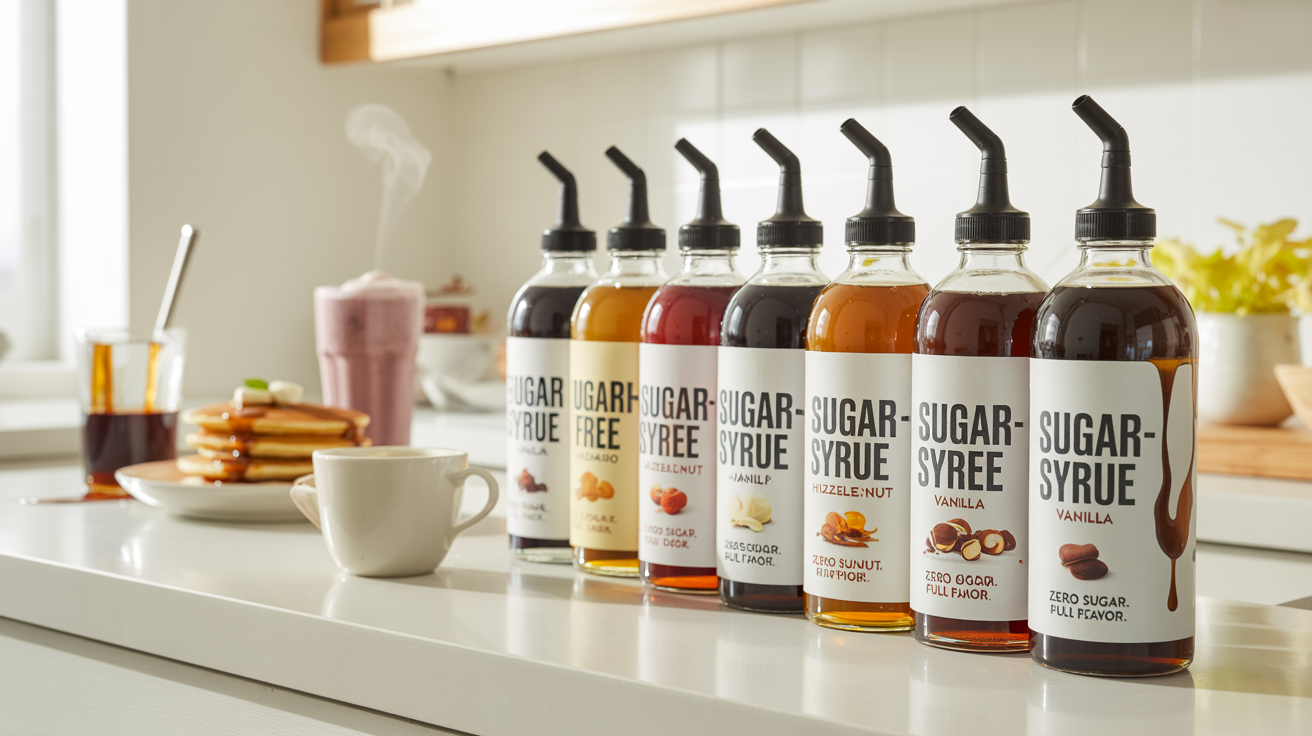Sugar Free Syrup: Healthier Alternatives for Sweetening Your Drinks Sugar Free Syrup: Healthier Alternatives for Sweetening Your Drinks 1. Introduction:...
Read MoreThe Ultimate Guide to Espresso Beans: What You Need to Know

The Ultimate Guide to Espresso Beans: What You Need to Know


Introduction
A brief overview of what instant espresso is.
Instant espresso is a fast and easy way to enjoy coffee, made from brewed coffee that has been turned into granules; unlike traditional espresso, which requires a machine and finely ground coffee beans, instant espresso is prepared in an espresso style without any machines. Espresso granules are mixed with hot water, and rapid espresso is ready in seconds. Ideal for hectic mornings or an afternoon booster, coffee connoisseurs no longer have to settle for bland, tasteless, caffeinated refreshments. Discover the realm of immediate espresso and taste the difference today!
Mention of related keywords: Instant Espresso Powder and Decaf Instant Espresso.
Most coffee enthusiasts love instant espresso powder both for its flavor and ease of use. This fine powder dispenses quickly, making it ideal for those searching for a fast caffeine fix or even for baking and cooking. And for those who seek a decaf option, decaf instant espresso is available without the jitters and offers a great taste. Both products serve as an easy way to enjoy espresso at home, whether by making a beverage or using it in cooking. Learn more about the benefits of immediate espresso powder and decaf instant espresso!
What is Instant Espresso?
Definition and explanation of Instant Espresso.
Instant espresso is brewed espresso dehydrated into fine granules or powder for quick preparation. Why would coffee aficionados need any other forms of espresso? It helps People get the distinctive rich taste they expect from espresso without needing any traditional brewing equipment. Hot water is all it takes. After, it takes no more than a few seconds to stir in the espresso granules and have an espresso full of aroma. This is the reason why many prefer it when they are in a hurry or need a dose of caffeine. It’s used in recipes and an entire range of beverages, which makes instant espresso a must-have for people wanting to elevate their coffee experience with no effort.
How it differs from regular brewed espresso.
Just like regular brewed espresso, instant espresso stands out when it comes to taste and preparation style. Regular espresso is produced by pouring hot water over finely ground coffee beans, producing a complex imbue. Conversely, immediate espresso is dehydrated and brewed in espresso granules, which removes a few of the intricate flavors and aromas found in traditional espresso. However, instant espresso avoids the need for specialized tools, making it ideal for coffee lovers when they are in a hurry. Due to the pleasure, this product provides many, instant espresso continues to gain popularity even while differentiating from traditional espresso.
The Process of Making Instant Espresso Powder
A step-by-step guide on how instant espresso powder is made.
Preparing instant espresso powder involves complex processes that enhance flavor while ensuring ease of use. First, the raw coffee from select origins is processed, and the beans are roasted. The roasted coffee beans are then pre-ground in order to boost extraction when they are eventually brewed. Following this, the coffee grounds are brewed in hot loaded water under pressure using an espresso machine. Liquid espresso is made as the final product, followed by dehydration, which could include freeze-drying and spray-drying. This step extracts moisture while keeping the essential flavors and aroma of the coffee. The end product, granules, is packed for easy storage and later reconstitution by the consumer. Savor the convenience and sensation of immediate espresso granules today!
The technology behind creating instant espresso powder.
Making instant espresso powder requires modern technology which adequately preserves the flavor and blends. The process begins with the roasting of first-class coffee beans, which are then brewed and ground into powder. Water is then heated and mixed into the coffee powder under high pressure, extracting all the flavors much like an espresso. The liquid is then dehydrated using freeze-dry or spray-dry techniques. Freeze-drying is done by dehydrating coffee while it is frozen to sublime away the moisture. In spray-drying, the liquid is atomized into droplets, which are dried and then turned into granules. Advanced technology like this makes it easier for coffee lovers to drink espresso without having to deal with machines.
Decaf Instant Espresso: The Best Option for Sensitive Drinkers
What is Decaf Instant Espresso?
Decaf instant espresso is a type of coffee product crafted for people who enjoy the taste of espresso but do not want to take in caffeine. This product is created from the selection of first-rate coffee beans, which undergo the process of decaffeination prior to brewing. The instant granules are easy to prepare – just combine the immediate espresso with hot water, and the drink is ready. Sensitive drinkers can enjoy the essence of espresso at any time without worrying about unwanted jitters. The taste of traditional espresso is very strong, and the taste of this instant blend does not differ much from it.
How Decaf Instant Espresso is made.
The production of instant decaf espresso starts with methods that guarantee all the flavors are preserved, along with removing caffeine. First, coffee beans go through a decaffeination process, normally using water extraction or CO2 extraction, which maintains the bean’s vital taste. After the decaf process, the beans are roasted and finely milled. The espresso extraction is done by brewing the ground coffee in hot water while applying pressure. The next step is moisture removal through a dehydration process, which can either be freeze-drying or spray-drying. As a result, granules are formed from instant decaf espresso. This revision omits all the replication and the tools used to simplify the text, which unlocks a completely new output.

The Benefits of Instant Espresso
Time-saving and convenient.
One of the popular types of espresso is instant espresso, which is loved by almost all coffee snobs as it is convenient and time-friendly. It also eliminates the need for a brewing kettle. Simply pour the granules into the water, and voila, you’ll have a delicious cup of coffee ready in no time. The convenience instant espresso offers makes it perfect for busy mornings or short breaks. Furthermore, immediate espresso is not just quick to prepare; its ease of use makes it perfect for those who do not want to clean espresso machines but still desire a quality drink.
Cost-effectiveness of Instant Espresso Powder vs. regular espresso.
When comparing regular espresso and an espresso powder version, it’s apparent that instant options tend to be cheaper. In many cases, instant espresso is cheaper than regular espresso, which makes it a favorite option for many in the espresso lover’s community. In a prepared instant, there is no requirement for fancy equipment appliances, as they can be prepared with hot water alone. In addition, immediate espresso is also less perishable, meaning less waste and more value for your purchase. The instant coffee powder’s affordability and ease of use make it a cheaper option for people who desire quality coffee at an inexpensive rate.
How to Make Instant Espresso at Home
Instructions on making a cup of Instant Espresso using powder.
To prepare a cup of instant espresso, all you need is espresso powder. The first step is to boil water either using a kettle or on the stove. If you are serving one, add one or two teaspoons of espresso powder into a mug. When the water starts to boil, pour around 6 ounces of hot water over the espresso powder. Stir the granules until it is fully incorporated into the mixture. During preparation, additional sugar, milk, or syrups could be used to customize your espresso. A perfect espresso is now within arm’s reach in just a matter of minutes!
Creative ways to use instant espresso powder in recipes (baking, ice cream, etc.).
Owing to its versatility, instant espresso powder works wonders in recipes that go far beyond coffee. One unique application is in baking; adding just one teaspoon to chocolate cake or brownie batter concentrates on the espresso flavor while deepening the richness. You can also add immediate espresso to the base of ice cream for a wonderful touch of coffee flavor. Furthermore, feel free to blend it into smoothies or yogurt for extra energy. For some creativity, try adding espresso powder to water-based sauces or marinades to add flavor to savory dishes. For culinary imagination, instant espresso powder can now be an essential pantry staple!

Best Brands of Instant Espresso to Buy
Reviews of top brands that sell instant espresso powder.
There are many brands of instant espresso that stand out in the market and can be considered the best to buy. Both coffee lovers and professionals regard Medaglia D’oro highly thanks to its country’s deep flavor combined with smooth texture. Another deft is Starbucks VIA immediate Espresso, which boasts a powerful taste comparable to freshly made espresso. Nescafé Taster’s Choice also gets acclaim, providing a flavorful blend in instant form. All these brands have their differences, which ensure that every consumer has something to enjoy. Be sure to try consumers so that you can find your favorite cup!
Recap of the benefits of Instant Espresso.
As I stated earlier, instantaneous espresso provides several advantages that ensure its preference among coffee enthusiasts. In an environment driven by performance, having such ease allows one to meticulously craft espresso within minutes. Instant espresso powder is more economical, offering cheaper servings compared to regular instant espresso. Additionally, it can be applied to develop different recipes like ice cream and baked treats. The long shelf life of instant espresso reduces waste, making it a valuable addition to your kitchen cabinet. Leading a busy lifestyle shouldn’t mean forgoing a good coffee, so why not try instant espresso? It’s as easy as pouring hot water over and enjoying a steaming cup of coffee without the fuss!
Popular Posts
Cortado Coffee: A Perfect Balance of Espresso and Milk
Cortado Coffee: A Perfect Harmony of Espresso and Milk! Cortado Coffee: A Perfect Harmony of Espresso and Milk! Introduction A...
Read MoreCoffee Creamer Flavors for a Healthier Cup
Coffee Creamer Flavors with the Best Ingredients Coffee Creamer Flavors with the Best Ingredients 1. Introduction Brief overview of the...
Read MoreWhite Coffee: The Unique Brew You Need to Try Today
Experience the Smooth Taste of White Coffee: Your New Favorite Drink! Experience the Smooth Taste of White Coffee: Your New...
Read MoreCortadito Coffee: A Sweet, Bold Cuban Espresso Drink
Cortadito Coffee: Why This Cuban Drink Should Be Your Next Favorite Cortadito Coffee: Why This Cuban Drink Should Be Your...
Read More
Introduction
A brief overview of what instant espresso is.
Instant espresso is a fast and easy way to enjoy coffee, made from brewed coffee that has been turned into granules; unlike traditional espresso, which requires a machine and finely ground coffee beans, instant espresso is prepared in an espresso style without any machines. Espresso granules are mixed with hot water, and rapid espresso is ready in seconds. Ideal for hectic mornings or an afternoon booster, coffee connoisseurs no longer have to settle for bland, tasteless, caffeinated refreshments. Discover the realm of immediate espresso and taste the difference today!
Mention of related keywords: Instant Espresso Powder and Decaf Instant Espresso.
Most coffee enthusiasts love instant espresso powder both for its flavor and ease of use. This fine powder dispenses quickly, making it ideal for those searching for a fast caffeine fix or even for baking and cooking. And for those who seek a decaf option, decaf instant espresso is available without the jitters and offers a great taste. Both products serve as an easy way to enjoy espresso at home, whether by making a beverage or using it in cooking. Learn more about the benefits of immediate espresso powder and decaf instant espresso!
What is Instant Espresso?
Definition and explanation of Instant Espresso.
Instant espresso is brewed espresso dehydrated into fine granules or powder for quick preparation. Why would coffee aficionados need any other forms of espresso? It helps People get the distinctive rich taste they expect from espresso without needing any traditional brewing equipment. Hot water is all it takes. After, it takes no more than a few seconds to stir in the espresso granules and have an espresso full of aroma. This is the reason why many prefer it when they are in a hurry or need a dose of caffeine. It’s used in recipes and an entire range of beverages, which makes instant espresso a must-have for people wanting to elevate their coffee experience with no effort.
How it differs from regular brewed espresso.
Just like regular brewed espresso, instant espresso stands out when it comes to taste and preparation style. Regular espresso is produced by pouring hot water over finely ground coffee beans, producing a complex imbue. Conversely, immediate espresso is dehydrated and brewed in espresso granules, which removes a few of the intricate flavors and aromas found in traditional espresso. However, instant espresso avoids the need for specialized tools, making it ideal for coffee lovers when they are in a hurry. Due to the pleasure, this product provides many, instant espresso continues to gain popularity even while differentiating from traditional espresso.
The Process of Making Instant Espresso Powder
A step-by-step guide on how instant espresso powder is made.
Preparing instant espresso powder involves complex processes that enhance flavor while ensuring ease of use. First, the raw coffee from select origins is processed, and the beans are roasted. The roasted coffee beans are then pre-ground in order to boost extraction when they are eventually brewed. Following this, the coffee grounds are brewed in hot loaded water under pressure using an espresso machine. Liquid espresso is made as the final product, followed by dehydration, which could include freeze-drying and spray-drying. This step extracts moisture while keeping the essential flavors and aroma of the coffee. The end product, granules, is packed for easy storage and later reconstitution by the consumer. Savor the convenience and sensation of immediate espresso granules today!
The technology behind creating instant espresso powder.
Making instant espresso powder requires modern technology which adequately preserves the flavor and blends. The process begins with the roasting of first-class coffee beans, which are then brewed and ground into powder. Water is then heated and mixed into the coffee powder under high pressure, extracting all the flavors much like an espresso. The liquid is then dehydrated using freeze-dry or spray-dry techniques. Freeze-drying is done by dehydrating coffee while it is frozen to sublime away the moisture. In spray-drying, the liquid is atomized into droplets, which are dried and then turned into granules. Advanced technology like this makes it easier for coffee lovers to drink espresso without having to deal with machines.
Decaf Instant Espresso: The Best Option for Sensitive Drinkers
What is Decaf Instant Espresso?
Decaf instant espresso is a type of coffee product crafted for people who enjoy the taste of espresso but do not want to take in caffeine. This product is created from the selection of first-rate coffee beans, which undergo the process of decaffeination prior to brewing. The instant granules are easy to prepare – just combine the immediate espresso with hot water, and the drink is ready. Sensitive drinkers can enjoy the essence of espresso at any time without worrying about unwanted jitters. The taste of traditional espresso is very strong, and the taste of this instant blend does not differ much from it.
How Decaf Instant Espresso is made.
The production of instant decaf espresso starts with methods that guarantee all the flavors are preserved, along with removing caffeine. First, coffee beans go through a decaffeination process, normally using water extraction or CO2 extraction, which maintains the bean’s vital taste. After the decaf process, the beans are roasted and finely milled. The espresso extraction is done by brewing the ground coffee in hot water while applying pressure. The next step is moisture removal through a dehydration process, which can either be freeze-drying or spray-drying. As a result, granules are formed from instant decaf espresso. This revision omits all the replication and the tools used to simplify the text, which unlocks a completely new output.

The Benefits of Instant Espresso
Time-saving and convenient.
One of the popular types of espresso is instant espresso, which is loved by almost all coffee snobs as it is convenient and time-friendly. It also eliminates the need for a brewing kettle. Simply pour the granules into the water, and voila, you’ll have a delicious cup of coffee ready in no time. The convenience instant espresso offers makes it perfect for busy mornings or short breaks. Furthermore, immediate espresso is not just quick to prepare; its ease of use makes it perfect for those who do not want to clean espresso machines but still desire a quality drink.
Cost-effectiveness of Instant Espresso Powder vs. regular espresso.
When comparing regular espresso and an espresso powder version, it’s apparent that instant options tend to be cheaper. In many cases, instant espresso is cheaper than regular espresso, which makes it a favorite option for many in the espresso lover’s community. In a prepared instant, there is no requirement for fancy equipment appliances, as they can be prepared with hot water alone. In addition, immediate espresso is also less perishable, meaning less waste and more value for your purchase. The instant coffee powder’s affordability and ease of use make it a cheaper option for people who desire quality coffee at an inexpensive rate.
How to Make Instant Espresso at Home
Instructions on making a cup of Instant Espresso using powder.
To prepare a cup of instant espresso, all you need is espresso powder. The first step is to boil water either using a kettle or on the stove. If you are serving one, add one or two teaspoons of espresso powder into a mug. When the water starts to boil, pour around 6 ounces of hot water over the espresso powder. Stir the granules until it is fully incorporated into the mixture. During preparation, additional sugar, milk, or syrups could be used to customize your espresso. A perfect espresso is now within arm’s reach in just a matter of minutes!
Creative ways to use instant espresso powder in recipes (baking, ice cream, etc.).
Owing to its versatility, instant espresso powder works wonders in recipes that go far beyond coffee. One unique application is in baking; adding just one teaspoon to chocolate cake or brownie batter concentrates on the espresso flavor while deepening the richness. You can also add immediate espresso to the base of ice cream for a wonderful touch of coffee flavor. Furthermore, feel free to blend it into smoothies or yogurt for extra energy. For some creativity, try adding espresso powder to water-based sauces or marinades to add flavor to savory dishes. For culinary imagination, instant espresso powder can now be an essential pantry staple!

Best Brands of Instant Espresso to Buy
Reviews of top brands that sell instant espresso powder.
There are many brands of instant espresso that stand out in the market and can be considered the best to buy. Both coffee lovers and professionals regard Medaglia D’oro highly thanks to its country’s deep flavor combined with smooth texture. Another deft is Starbucks VIA immediate Espresso, which boasts a powerful taste comparable to freshly made espresso. Nescafé Taster’s Choice also gets acclaim, providing a flavorful blend in instant form. All these brands have their differences, which ensure that every consumer has something to enjoy. Be sure to try consumers so that you can find your favorite cup!
Recap of the benefits of Instant Espresso.
As I stated earlier, instantaneous espresso provides several advantages that ensure its preference among coffee enthusiasts. In an environment driven by performance, having such ease allows one to meticulously craft espresso within minutes. Instant espresso powder is more economical, offering cheaper servings compared to regular instant espresso. Additionally, it can be applied to develop different recipes like ice cream and baked treats. The long shelf life of instant espresso reduces waste, making it a valuable addition to your kitchen cabinet. Leading a busy lifestyle shouldn’t mean forgoing a good coffee, so why not try instant espresso? It’s as easy as pouring hot water over and enjoying a steaming cup of coffee without the fuss!
Popular Posts
Blueberry Coffee: A Sweet and Fruity Coffee Experience
The Ultimate Guide to Blueberry Coffee: Recipes, Benefits The Ultimate Guide to Blueberry Coffee: Recipes, Benefits Introduction: The rise of...
Read MoreDecaf Coffee: Enjoy Rich Flavor Without the Caffeine Jitters
Health Benefits of Decaf Coffee: A Smarter Way to Enjoy Your Brew Health Benefits of Decaf Coffee: A Smarter Way...
Read MoreCortadito Coffee: A Sweet, Bold Cuban Espresso Drink
Cortadito Coffee: Why This Cuban Drink Should Be Your Next Favorite Cortadito Coffee: Why This Cuban Drink Should Be Your...
Read MoreCarbs in Coffee: What’s Really in Your Cup?
Carbs in Coffee: What You Need to Know Before Your Next Cup Carbs in Coffee: What You Need to Know...
Read MoreDiscover the Best Espresso Coffee for Rich, Bold Flavors
Master the Art of Espresso Coffee: Secrets to the Perfect Brew Master the Art of Espresso Coffee: Secrets to the...
Read MoreColombian Coffee: Discover the Rich Flavors of Colombia’s Best
Discover the Richness of Colombia Coffee: A Complete Guide Discover the Richness of Colombia Coffee: A Complete Guide Introduction to...
Read More










